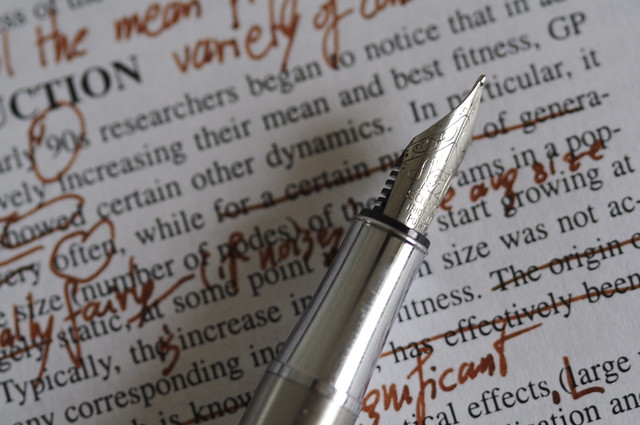
Photo from Nic McPhee under Creative Commons license
Hi,
As we approach end of year deadlines, I've been doing less science reading. I'm guessing others are in the same boat, so this is a small review. The focus this month is how we can do science in a way that leads to greater impact. Two articles are about writing science articles more clearly, two are about collaboration, and one is a call for academics to do more to promote action in sustainability. Enjoy!
SCIENCE ARTICLE WRITING / SCIENCE COMMUNICATIONS:
Many scientists bristle at the notion that we should write more clearly. But we also hate reading articles and finding they don't deliver on what the title and abstract promises. Mensh & Kording 2017 offers 10 rules for writing more clearly. Different disciplines have different norms around structure, language, etc., but I think this is a great place to begin. Short on time? Read Table 1 (on p8) which summarizes the rules and how to know if you get it wrong. I'm excited to try this for my next paper!
Ever wonder how scientists pick authorship order, sort out who did what, and decide who's on a paper at all? If so, you may want to skim Sauermann & Haeussler 2017. It's on the long and dense side, but has some interesting insights (especially if you're a scientist making those decisions). In general, contribution statements offer more info than author order (although they can be hard to read), see Figure 4. Figure 1 shows that after the first author, the last author is most likely to have played a broad role in the paper. Finally, I was struck by the "inclusion as an author" section on page 4 which lists an international standard for being an author which is significant higher than what I usually see. Basically, this is food for thought for folks who read and/or write a lot of science papers.
COLLABORATION:
As we increasingly focus on big, tough problems, collaboration across sectors is more important than ever. It's also really hard. In cross-sector projects I've worked on, differences in terminology, priorities, expertise, etc. have slowed down progress. The Bridge Collaborative is an initiative led by TNC aiming to help collaboration across environmental, development, and health sectors. Their new guidance report has insights for those of you doing this kind of cross-sector work (or aspiring to).
Bodin 2017 asks a more basic question: when and how does collaboration really make sense (with a specific focus on collaborative governance for environmental problems)? Their brief answer: "The capacity of collaborative governance to deliver sustainable solutions for any given environmental problem ranges from highly effective to essentially worthless." That may seem flippant, but he provides useful parameters to answer the question for a given context. The 1-page summary is better written than the longer version (which is broad enough to feel a bit unfocused), but the long version has details about knowledge diffusion and building functional social networks that people trying to work in this way will likely appreciate.
ADVICE FOR ACADEMIC INSTITUTIONS
Keeler et al 2017 is a paper led by some folks at the Natural Capital Project (with current and former TNC co-authors) calling for academic institutions and do more to help "serve society and the planet." It's a quick and well written read, but they have five main ideas: provide training to help students become environmental leaders (not just professors), recognize the value of applied / relevant work (which is sometimes seen as inferior to basic research), move faster (accepting uncertainty and the need for iteration), make people front and center in environmental science, and shift academic structure to encourage innovation (e.g. NatCap itself is one example of academics partnering with NGOs to do rapid applied science). I often meet academics frustrated that their work isn't being put to ues more, and this gives them some ideas of changes to promote at their institutions.
REFERENCES:
Bodin, Ö. (2017). Collaborative environmental governance: Achieving collective action in social-ecological systems. Science, 357(6352), eaan1114. https://doi.org/10.1126/science.aan1114
https://doi.org/10.1126/science.aan1114
Keeler, B. L., Chaplin-Kramer, R., Guerry, A. D., Addison, P. F. E., Bettigole, C., Burke, I. C., … Vira, B. (2017). Society Is Ready for a New Kind of Science—Is Academia? BioScience, 67(7). https://doi.org/10.1093/biosci/bix051
Mensh, B., & Kording, K. P. (2017). Ten simple rules for structuring papers. PLOS Computational Biology, 13(9). https://doi.org/10.1371/journal.pcbi.1005619
Sauermann, H., & Haeussler, C. (2017). Authorship and contribution disclosures. Science Advances, 3(11), e1700404. https://doi.org/10.1126/sciadv.1700404
Tallis H, Kreis K, Olander L, Ringler C et al. 2017. Bridge Collaborative Practitioner’s Guide: Principles and Guidance for Cross-sector Action Planning and Evidence Evaluation. Washington DC: The Nature Conservancy